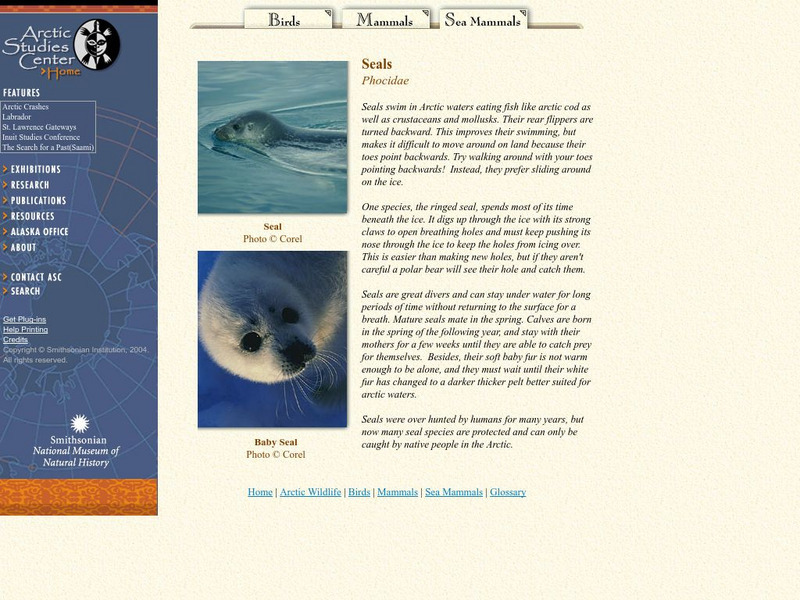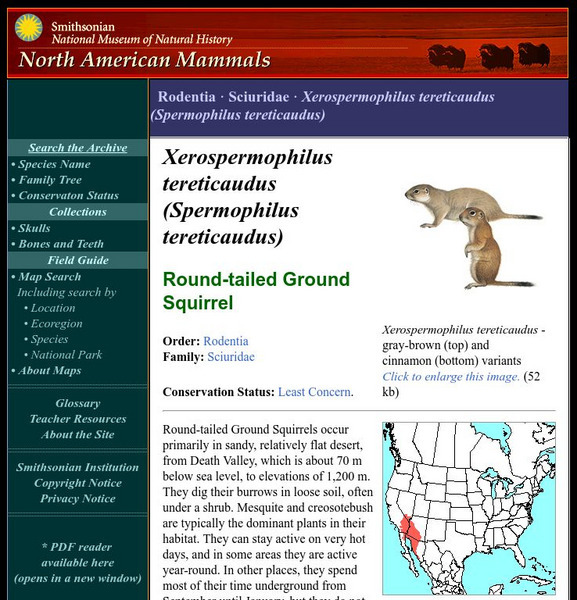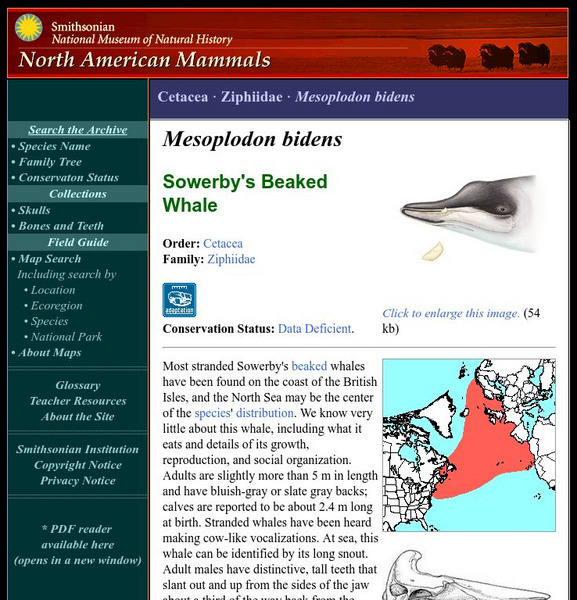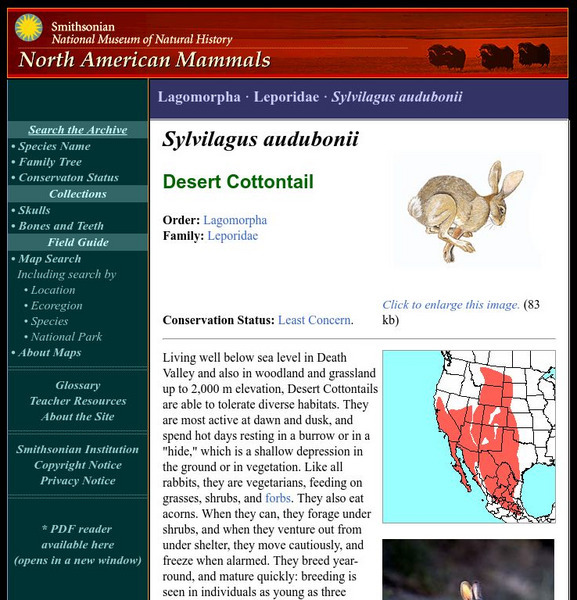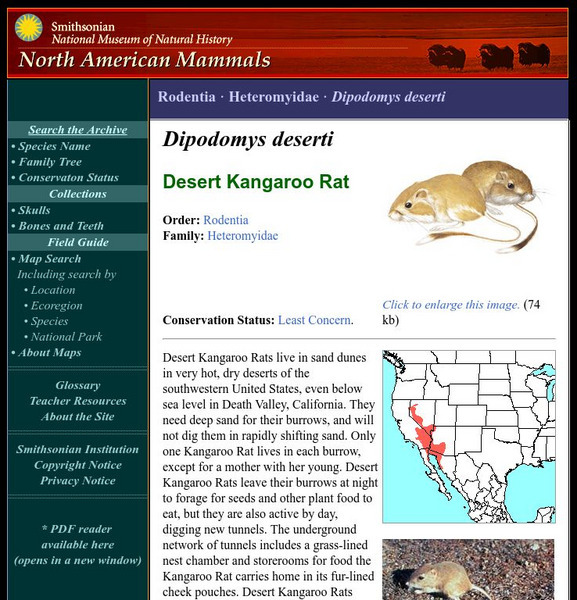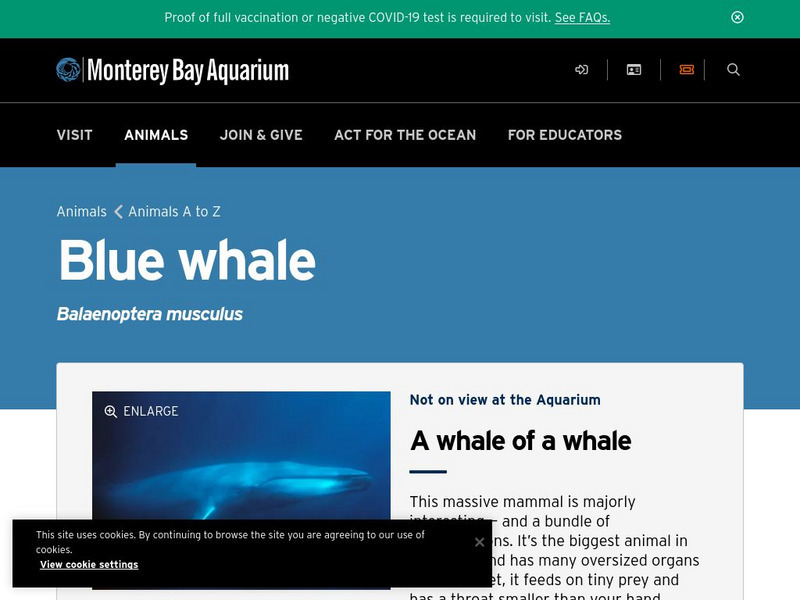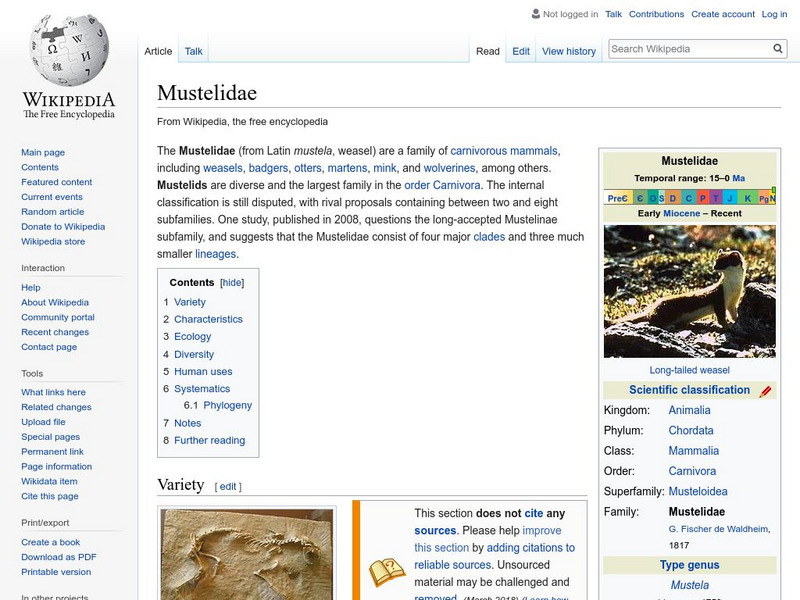Other
Ocean Oasis: Field Guide
Ocean Oasis is a giant-screen film that depicts Mexico's Sea of Cortes and the Baja California desert. This companion site features much of the information the film has, such as beautiful images of animals, water, and land that have...
Smithsonian Institution
National Museum of Natural History: Arctic Studies Center Mammals Seals
This Smithsonian website has a brief, but thorough, article on the Seal that also includes pictures.
Sea World Parks & Entertainment
Sea World: Marine Mammal Training
Learn how SeaWorld trains its marine animals.
E-learning for Kids
E Learning for Kids: Science: Caribbean Sea: How Can We Classify Animals?
Welcome to Hideaway Island where five pirates need to find crews for their ships. Join in and learn about animals with backbones.
Sea World Parks & Entertainment
Sea World: Polar Bears
Outlines the characteristics of the polar bear, including classification, habitat, behaviors, and conservation. Helps students identify with polar bears with a list of "Books for Young Readers." Information at a level of upper...
Other
Discovery of Sound in the Sea
Discover how animals use sound to communicate. Provides links to the uses of sound, effects of sound as well as sound production and reception.
Sea World Parks & Entertainment
Sea World: Animal Bytes: African Hedgehog
Brief, but concise resource contains helpful information on this little creature. Provides scientific classification of the African hedgehog, fast facts, fun facts as well as additional information on ecology and conservation.
Other
Encounters: Wild Explorers: Polar Bear
Learn fascinating facts about the incredible polar bear and listening to them growl.
Smithsonian Institution
National Museum of Natural History: American Mammals: Beach Vole
Found only on Muskeget Island, the Beach Vole became isolated from its closest relative, the Meadow Vole, about 3,000 years ago during a glacial melt and rise in sea level. It is the only mammal endemic to Massachusetts, the result of...
Smithsonian Institution
National Museum of Natural History: American Mammals: Round Tailed Ground Squirrel
Round-tailed Ground Squirrels occur primarily in sandy, relatively flat desert, from Death Valley, which is about 70 m below sea level, to elevations of 1,200 m. They dig their burrows in loose soil, often under a shrub. Learn more about...
Smithsonian Institution
National Museum of Natural History: American Mammals: Sowerby's Beaked Whale
Most stranded Sowerby's beaked whales have been found on the coast of the British Isles, and the North Sea may be the center of the species' distribution. We know very little about this whale, including what it eats and details of its...
Smithsonian Institution
National Museum of Natural History: American Mammals: Stejneger's Beaked Whale
Thirty-one of the 48 sightings of Stejneger's beaked whale have come from Alaskan waters. It is suspected this species favors deep waters, including the Aleutian Trench and the Aleutian Basin, which is some 3,500 m deep, rather than the...
Smithsonian Institution
National Museum of Natural History: American Mammals: San Diego Pocket Mouse
The San Diego Pocket Mouse occurs in desert and coastal habitats in southern California, Mexico, and northern Baja California, from sea level to at least 1,400 m. Yellowish or orange hair on its sides contrasts with a dark brown back,...
Smithsonian Institution
National Museum of Natural History: American Mammals: Desert Cottontail
Living well below sea level in Death Valley and also in woodland and grassland up to 2,000 m elevation, Desert Cottontails are able to tolerate diverse habitats. They are most active at dawn and dusk and spend hot days resting in a...
Smithsonian Institution
National Museum of Natural History: American Mammals: Desert Kangaroo Rat
Desert Kangaroo Rats live in sand dunes in very hot, dry deserts of the southwestern United States, even below sea level in Death Valley, California. They need deep sand for their burrows, and will not dig them in rapidly shifting sand....
Smithsonian Institution
National Museum of Natural History: American Mammals: Insular Vole
There have been only scattered observations of the Insular Vole since 1885 because the two islands in the Bering Sea off the coast of Alaska where it lives are rather inaccessible. The Voles live in burrows dug in moist lowland areas, at...
Tramline
Tramline, Inc.: Virtual Ocean Field Trip
In this enchanting site, students will learn basic principles about oceans and will be introduced to an assortment of sea life, both plant and animal. Other interesting ocean links can be found on the teacher resource section of this link.
Monterey Bay Aquarium
Monterey Bay Aquarium: Blue Whale (Balenoptera Musculus)
Resource that gives information on the diet, range, relatives of the blue whale. Conservation notes and cool facts are also included. There are links to similar information on dozens of other types of marine life.
San Diego Zoo Global
San Diego Zoo: Manatee
This engaging resource from the San Diego Zoo provides extensive information on manatees including details about their habitat, physical characteristics, size, diet, family life, conservation status, and fun facts.
PBS
Pbs Nature: Otters
Discover more about how otters live, what they eat and how they socialize when you visit this informative resource. This condensed site will benefit students who need help narrowing their research information.
Wikimedia
Wikipedia: Mustelidae
This Wikipedia encyclopedia article explores mustelids, a family of carnivorous mammals. Content includes a look at the range of species in this family, including a look at their common characteristics.
Texas Instruments
Texas Instruments: Jason: Can You Breathe Like a Pinniped?
From Shore to Sea: Pinnipeds are marine mammals that spend a great deal of time in the water. Like all marine mammals, pinnipeds breathe air through their lungs. In order to breathe, they must come up to the surface for air.
Texas Instruments
Texas Instruments: Jason: Pinniped Body Shape Conserving Warmth
From Shore to Sea: To survive in cold ocean environments an organism's body must be adapted to life under water. A body will cool very quickly when in contact with water. The body shape of an organism is one adaptation that helps to...
CK-12 Foundation
Ck 12: Earth Science: Types of Marine Organisms
[Free Registration/Login may be required to access all resource tools.] Provides an overview of the organisms living in the sea.



